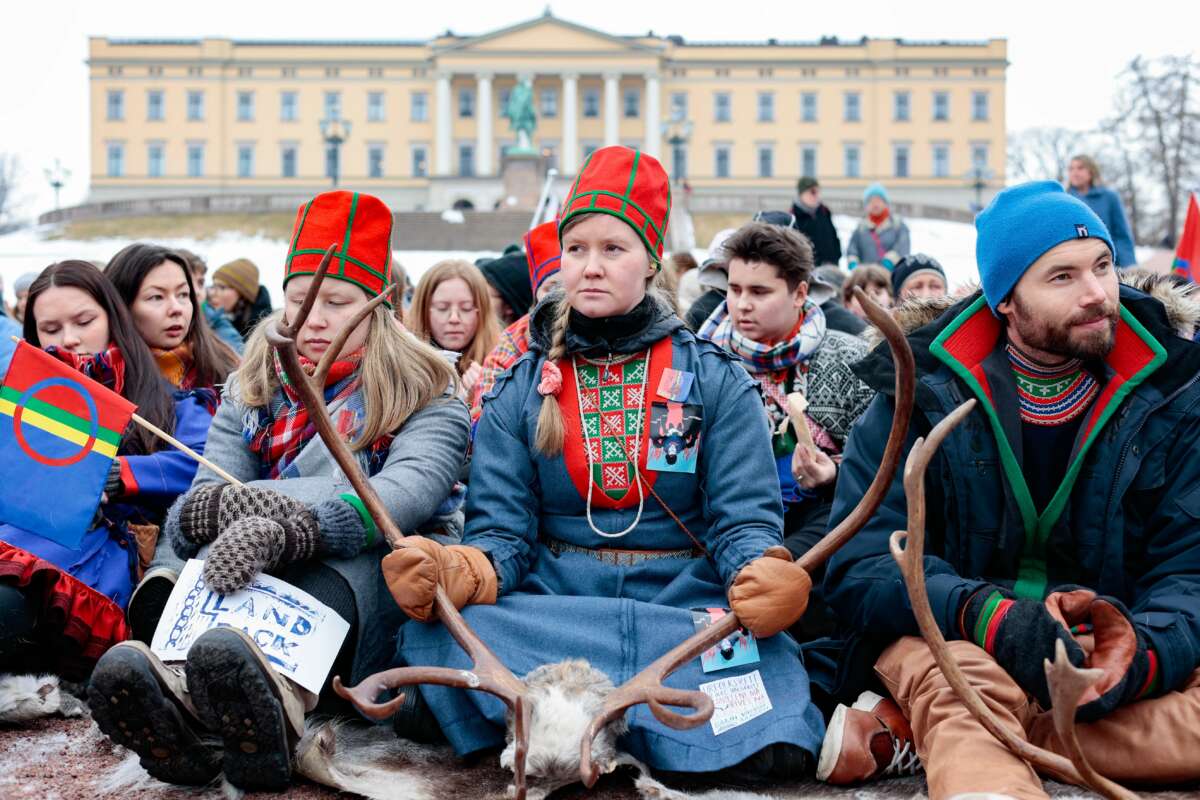This story was originally published by Grist. You can subscribe to its weekly newsletter here.
Indigenous Sámi activists intensified their protests against an illegal wind farm on Thursday, blocking the entrances of several Norwegian ministries. Led by Sámi youth, protesters are demanding the removal of a wind farm built in Sápmi, the traditional territory of the Sámi, which stretches across northern Norway, Sweden, Finland, and into Russia.
The Fosen Vind park, one of Europe’s largest onshore wind farms, consists of 151 turbines near the city of Trondheim, on the country’s central-west coast. The park is owned by Norwegian, Swiss, and German energy companies, and was built in a grazing area crucial to Sámi reindeer herders, threatening their traditional livelihoods and culture.
“The state must immediately stop the ongoing violations of the Sámi reindeer herders’ human rights and take measures to reparation (sic) to redress violations of human rights,” Silje Karine Muotka, president of the Sámi Parliament of Norway, wrote in a letter to the U.N. “The windmills must be demolished, and the area restored to reindeer grazing land.”
Norway’s Supreme Court ruled in 2021 that the wind farm violated the Sámi’s human rights and was constructed illegally. The Norwegian government has yet to take action on the ruling. Sámi land defenders in Norway’s capital of Oslo were not available for comment, but campaigners told Reuters they would close down the state, ministry by ministry, until the windmills are removed. Sámi leaders say Norway’s failure to follow the law has left them with little choice but to protest.
Norway’s government-run broadcaster, NRK, reported that Sámi reindeer herders from the Fosen district have begun traveling to Oslo to support the protests, and on Thursday morning, Greenpeace activists climbed the Ministry of Oil and Energy to hang a banner reading “Land Back.” Some campaigners chained themselves to the entrance of the Ministry of Culture and Equality before being removed, detained, and fined by police. Representatives of the Sámi Parliament have also begun consultations with the Ministry of Petroleum and Energy and the Minister of Agriculture — Sámi reindeer herders have demanded the handling of Fosen be handed to the Ministry of Agriculture to avoid conflicts of interest.
“They should have seen it coming for violating human rights,” environmental activist Greta Thunberg, who has joined Sámi land defenders in Oslo, told Reuters.
As protests spread, the Sámi Parliament of Norway has appealed to the United Nations Special Rapporteur on the rights of Indigenous peoples to intervene.
In 2018, a U.N. human rights committee asked Norway to stop construction on a power plant that would become part of the final wind farm. However, the Norwegian government disregarded the request once construction passed domestic legal hurdles.
Representatives for Prime Minister Jonas Gahr Støre and the Government Security and Service Organisation, the security force responsible for detaining Sámi land defenders, did not respond to a request for comment. Attempts to reach the U.N.’s Special Rapporteur also went unreturned.
Norway is often seen as a leader in global human rights and is home to the Nobel Peace Prize, but, like other Nordic countries, it has a long history of racism directed at the Sámi people. There’s also a long history of Sámi resistance in the region.
Most of Norway’s electricity is generated by hydropower, but approximately 10 percent comes from wind generation. That’s according to Edgar Hertwich, a professor in industrial ecology at Norwegian University of Science and Technology, who said growth in energy demand has outstripped production. That increase, coupled with delivery “gaps” in the country’s electrical grid, have led to the construction of more green energy projects.
“The wind park that’s under discussion is about the amount of energy that’s needed for the city of Trondheim with 220,000 inhabitants or two of the largest industrial companies in the region,” Hertwich said, adding that the location of Fosen and other wind farms also threaten local ecosystems, particularly those of birds and bats.
“It’s clear that the locations that have been chosen are not the ones that lead to the lowest environmental impacts, and they obviously don’t lead to lower social impacts,” Hertwich said. “There are some poor decisions that were made 10 years ago that we have to live with today.”
Media that fights fascism
Truthout is funded almost entirely by readers — that’s why we can speak truth to power and cut against the mainstream narrative. But independent journalists at Truthout face mounting political repression under Trump.
We rely on your support to survive McCarthyist censorship. Please make a tax-deductible one-time or monthly donation.
